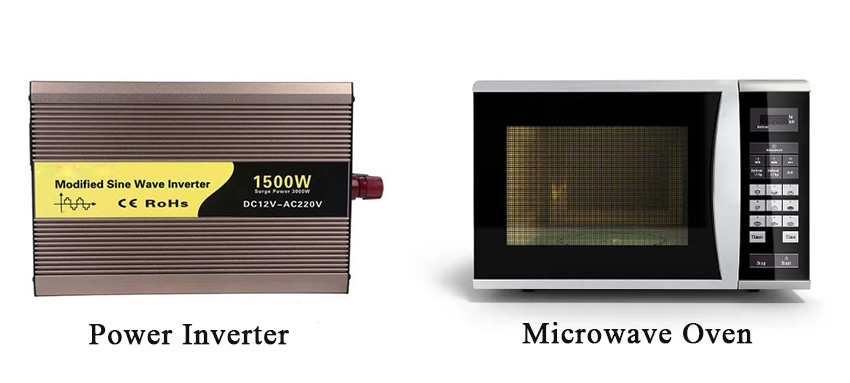A 1500W inverter is an electrical device that converts DC power into AC power for household appliances. It can supply up to 1500 watts of continuous power, allowing it to operate a range of devices. When connected to a microwave, it enables the microwave to function even without a traditional AC power outlet. This setup is useful for outdoor activities, camping, or emergency situations where conventional electricity is unavailable. The inverter must be appropriately sized to handle the microwave's power requirements, ensuring safe and efficient operation. In this article, we will talk something about power inverter and microwave.

How to Calculate Microwave Inverter Power Requirements:
The formula is microwave watts x number of hours used = inverter size. However you have to factor in the surge watts and running watts to find the right inverter capacity. The surge capacity of an small inverter is usually double its running capacity, so a 2000 watt inverter has a 4000 watt surge limit. Their ratings are usually given in running watts, but check to be sure.
If you have an 800W microwave, do you only need an 800W capacity sine wave power inverter to run it? It's not as simple as one might think. Microwave surge power can be twice its operating power, so an 800W inverter must have a peak capacity of 1600W. If the surge power is 3-4 times the operating power, a larger inverter is needed.
Large appliances like air conditioners, refrigerators and even hot tubs can have start-up and run-up wattage requirements. The starting or surge wattage is the power required to initialize the appliance.
There are three important things to remember. First, when buying a microwave oven, try to choose an energy efficient model, second, check the operating watts and surge watts. Third, your inverter must be able to support surge watts.
Factors That Affect Microwave Power Consumption:
The amount of power you actually consume depends on the frequency of use. For example, a 1200W microwave oven consumes 1200W per hour. but if you use it for 30 minutes, it's only 600W. you reheat the food in the microwave for another 15 minutes or so, that's 300W.
It's important to remember this as it applies to all appliances including TVs, computers, refrigerators, air conditioners and more. The wattage usage is just a guide as you may end up using less or more. If you only use the microwave to heat your coffee water for a few seconds a day, you don't need a large inverter.
Also, settings affect power consumption. This is because cooking at higher temperatures requires more power. Even if you have an energy-efficient microwave oven, if it's set to maximum and runs for a few hours, the power usage will go up.
The quality of the microwave is also crucial. There are some microwave ovens that are made for for the home while others are made for RVs and campers. It is important to choose the one that best suits your needs. Your choice determines how much energy you need to set aside.
What is the Right Battery Bank Size for Microwaves?
A 1000W inverter running a 700W microwave requires at least a 12V, 150Ah battery pack. Assuming a surge power of 1600W, twice the running power. If the starting power is 3-4 times higher, increase the battery capacity. As with all solar, it would be nice if you could get more batteries.
The inverters get their power from the battery bank, so they have to be large enough to handle the microwave. If you're using solar power, the solar panels will power the batteries. The inverter is connected to the batteries and converts the power to AC for the microwave. This is how AC powered appliances work on solar.
Battery capacity is determined in amps and volts. Amps x volts = watts. Most microwaves use 5 amps when in use, but during the initial surge this could be as high as 20 amps.
You have the option of purchasing single or multiple batteries, as long as the capacity matches the inverter and microwave. However, if you are using only solar panels, use multiple batteries. In the event of cloudy weather, it may take several hours for the solar panels to feed the required amperage into the batteries. And the more batteries you have, the faster you can start the microwave.
